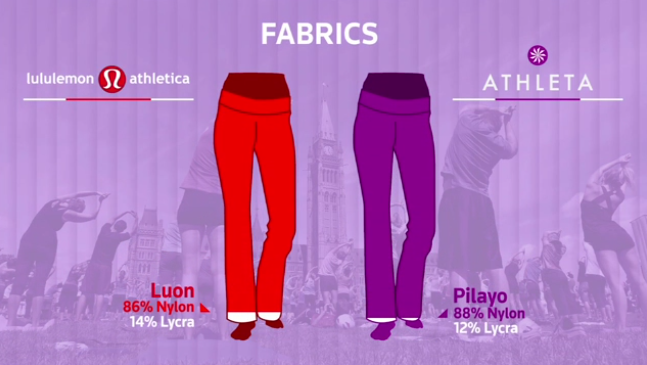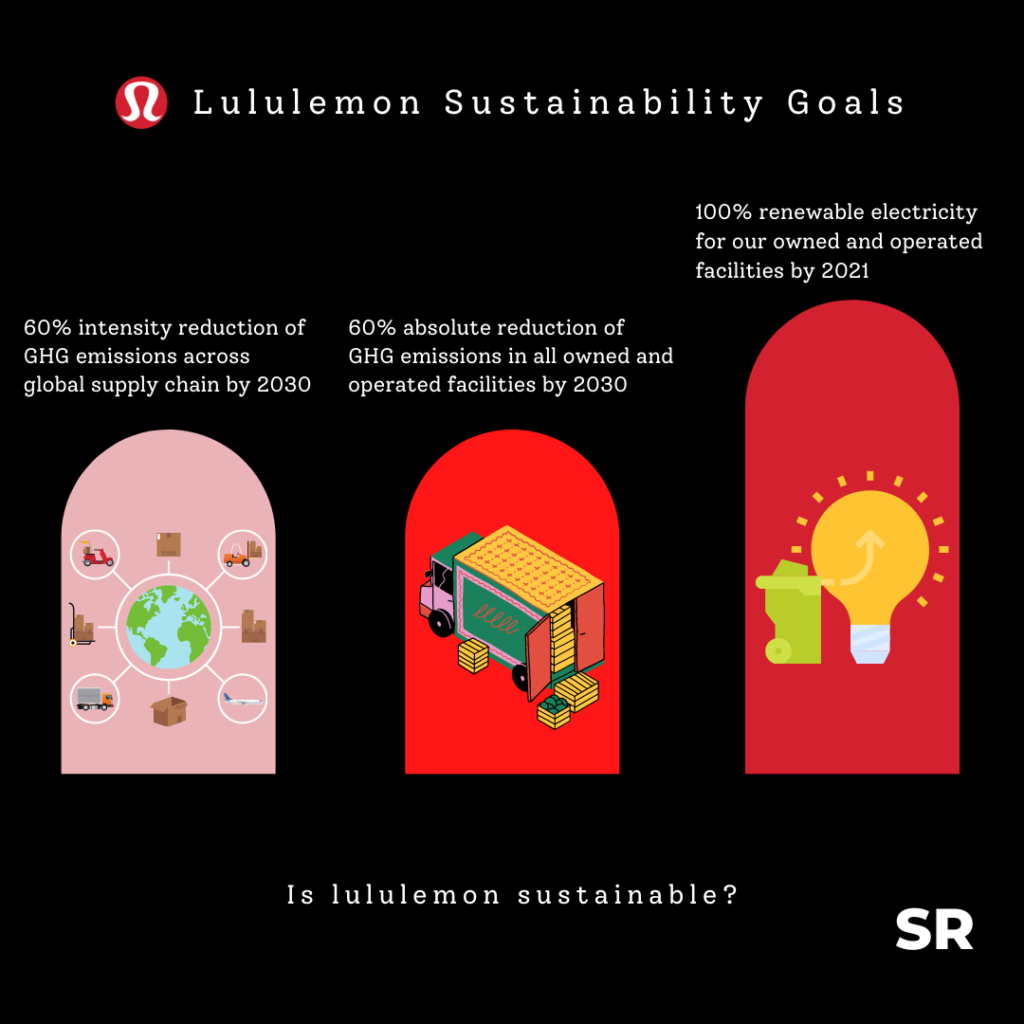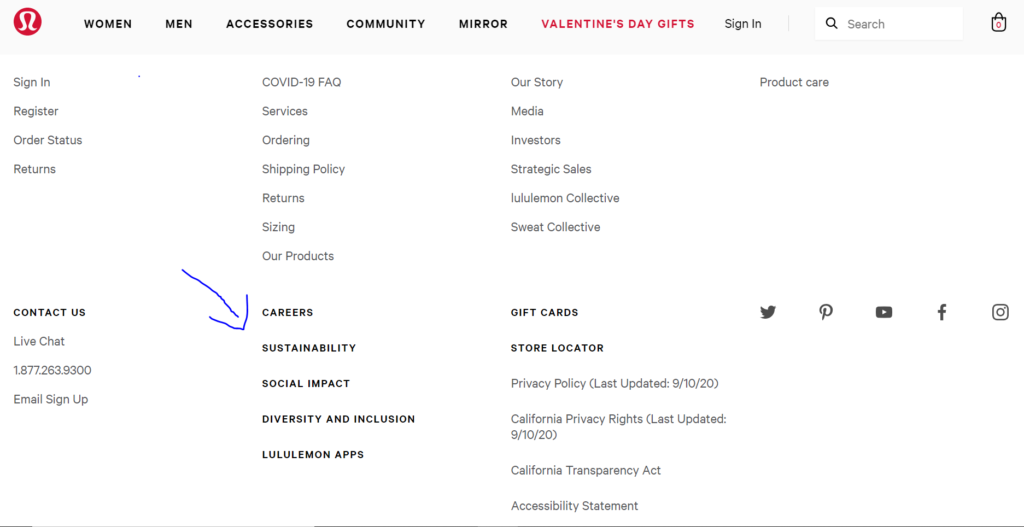Trendy athleisure brands need more than just bullet points to take action. Is Lululemon a sustainable brand? (updated September 2022)
The Canadian yoga pants producer has become a cultural staple in the world of lifestyle and fitness. The brand evokes feelings of zen, athleticism, style, and casual comfort all mixed into one.
They certainly have the heartstrings of active soccer moms and, more recently, trendy bros. But is Lululemon’s sustainability sustainable?
Busy? Try the speed read.
The scoop: Lululemon is a cultural staple in the world of athleisure. Sustainability is not a core aspect of their brand strategy.
Some talking points:
- Lululemon uses polybags (plastic) for finished products sent to distribution centers.
- Most of their materials are not eco-friendly. They are working on that.
- Four of five global distribution centers are zero-waste.
- Lululemon is pretty transparent about its carbon footprint and accountability.
Bottom line: They are taking some steps toward sustainability, but I have to hold Lululemon to a higher standard than that. They have an opportunity to lead the athleisure industry, and they don’t even come close.
Dig deeper → 4 min
Lululemon founder story
Chip Smith was certainly a brand-building guru with an eye for innovation. He, along with some amazingly talented designers, is why Lululemon is what it is today – even though he is no longer involved with the company.
He has a questionable reputation (at best) for routinely making strange remarks about women’s bodies.
For example, he said birth control causes breast cancer/leads to divorce and that yoga pants don’t work for women whose thighs touch. Not the best look for a female-dominated market.
In response to Patagonia founder Yvon Chouinard’s $3 billion donation, Lululemon’s billionaire founder Chip Wilson and his wife Summer have revealed a Canadian $100 million (USD 75.8 million) donation to the B.C. Parks Foundation.
For more on the company’s current CEO, check out his thoughts on brand strategy here:
Industry-standard and company size
Clothing companies have a low standard of sustainability. High-end clothing brands like Lululemon have an even poorer reputation. Their main competitors are Nike and Under Armour. Enough said.
Lululemon is also a publicly traded company with over $3 billion in revenue last year, so they are a large company with a global presence. We must judge their environmental & ethical rating through a global lens.
Material assessment
Most of Lulu’s materials are not eco-friendly. They rely heavily on Nylon and Pylon. 75% of their Pylon comes from recycled materials. Their nylon fiber is not recycled.

Lululemon’s website shares how they use “responsibly sourced and more sustainable materials wherever possible,” but this wording leaves the door open for inaction.
They recycle well to make all their global distribution centers Zero Waste by reusing and recycling more than 90% of their materials.
Four out of five have achieved zero waste status. Their newest distro, built in 2019, is expected to reach that status this year.
Packaging
Their sustainable packaging policy includes steps to keep the packaging to a minimum.
One example? They switched paper-based packaging to FSC-Certified materials (Forest Stewardship Council), which make up their product hang tags, holiday boxes, and gift cards and sleeves.

Lululemon uses polybags (plastic) when shipping finished products to their distribution centers. Their reasoning: “they offer the best protection for our products”.
I’m not a supply chain/logistics expert, but I don’t know if clothing items are that delicate. I’m sure there are sustainable alternatives that may just cost a few cents extra.
They also mention that eliminating polybags would ultimately increase waste with more damaged products. Other companies (I guess that’s supposed to be an excuse) face a similar issue.
Half-sour reaction. I believe them, but I don’t think it’s good enough of an explanation: no charts, graphs, third-party commissioned reports, or well-outlined plans to fix it.
Much of the website’s information for packaging suggests exploration rather than execution.
Climate and energy use
Lululemon is sustainable if its supply chain says so.
Lululemon’s climate strategy distinguishes the supply chain from owned and operated facilities. Their strategy encompasses renewable energy, increased efficiency, r&d focused on material innovation, and industry collaboration.

Expect 100% renewable energy this year, plus a major reduction in greenhouse gas (GHG) emissions over this decade. Not a huge fan of sustainability goals that exceed five years, but won’t knock them for it.
How will Lululemon achieve its sustainability goals?
In North America, Lululemon plans to hit 100% renewable energy through renewable credits (offset market) and Power Purchase Agreements (PPA).
PPAs are a way to hire third-party developers to manage electricity for you. It’s like renting power/electricity for a pre-determined period.
They also plan to source more sustainable raw materials and fibers, not seeing enough progress there. Lastly, they joined The Climate Group’s RE100, a coalition of companies increasing the supply and demand for renewable energy.
Transparency and ethics
Kudos to Lululemon for being up-front about polybags. Transparency brownie points. They also routinely report their carbon footprint to the Carbon Disclosure Project (CDP), an international standard for corporations.
Something to improve? The Climate & Sustainability section of their website is buried at the bottom.

I understand why a consumer brand needs a landing page centered around shopping. Still, sustainability for trendy clothing brands? That deserves a tab at the top. If it’s not a core pillar of your branding, you aren’t taking a hard enough stance. Maybe I’m being too harsh.
As mentioned above, their founder has a history of making rude remarks.
The CEO stepped down last year amid a sexual misconduct scandal (he had a multi-year relationship with a company designer). The company has a reputation for pressuring sales reps with unrealistic goals.
Last but not least, they use animal products in their product line. Their down is more eco-friendly, but only because it comes from bi-products in the food industry. To be honest, it’s smart. But gross. Why use it at all?
Their wool is not certified ‘responsible’. They still are looking for alternatives to animal-derived materials. As they look, millions of animals suffer.
A strange conglomerate for a company that markets itself on mindfulness & yoga.
Ongoing evaluation
Is Lululemon sustainable?
This company has been around for too long not to be doing more for environmental impact. Lululemon has an opportunity to lead the athleisure industry on sustainability efforts, but they don’t even come close.
While Lulu claims to make sustainability a centerpiece of its corporate policy and future goals, other brands with similar global challenges are outperforming the luxury-legging maker.
@lululemon – not bad. but less talking and more doing, please.
Did you enjoy this review? Check out our Better Brands page for more sustainable reviews!













No Comments